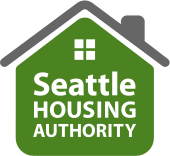SEATTLE—February 20, 2007—Unusual weather this winter, especially December’s severe windstorms and subsequent power outages, provided a valuable wake-up call to both SHA staff and residents.
Are we prepared for natural disasters and emergencies? How can we do better? What is SHA doing to help its residents ready themselves for days without electricity, heat, food, water and other resources?
According to Ginger Bonnell, SHA’s Emergency Preparedness and Recovery Coordinator, the agency is evaluating its emergency preparedness plans with an eye to improving them.
Foremost among SHA’s concerns is the need for dependable and systematic communication. If SHA staff and managers are better informed of conditions through SHA’s properties, they can do a better job of responding to resident needs where they are the most acute.
To help address this need, SHA is updating plans to use its Central Office basement as a “command center” that would serve as a communications hub. Four regional centers would report information about conditions at SHA high-rises and other communities to that hub. Two of the regional centers would be north of the Ship Canal (at PorchLight in Ballard and the other at the Operations Support Center in North Seattle), one south (at the Central Maintenance Facility in the Central District), and one in West Seattle (at the South Operations Facility).
Educating tenants and staff members is at the heart of SHA’s preparedness plan. To that end, SHA has worked with volunteers from the Red Cross and community educators from the Seattle Fire Department to inform people how to create their own plans for dealing with emergencies and how to assemble disaster kits with the supplies that will be most useful.
“SHA serves more than 25,000 residents,” said Bonnell, “and it is our goal to provide each household with basic information about preparing for emergencies.”
Every high-rise building has a disaster plan in place, she said, and every building conducts an evacuation drill at least once a year. Every multi-unit building has a supply cabinet stocked with emergency rations, water, lightsticks, and batteries, and every building office has been provided a radio for use in emergencies.
However, the supplies are not meant to be sufficient to provide rations and water to every building occupant for three days. This is the interval used by emergency planners as the minimum time during which all Seattle residents should be prepared to be as self-sufficient as possible. Accordingly, residents are encouraged to stockpile their own rations and water, and to assemble kits of supplies that are likely to be needed in an emergency: flashlights and batteries, a whistle, battery-powered radios and the like.
SHA is part of the City’s plans for providing the sheltering and feeding of large numbers of people. Most SHA facilities are likely shelter locations—and it is to such shelter locations that disaster officials send food, water, and blankets.
“The City is well aware that we house vulnerable populations who may need extra help in an emergency,” Bonnell said. “The City is doing everything it can to make sure that we at SHA are prepared to deal with emergencies, and we are working to prepare our residents and staff to deal with emergencies.”
